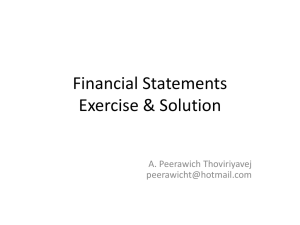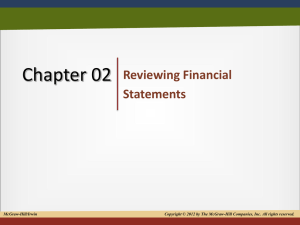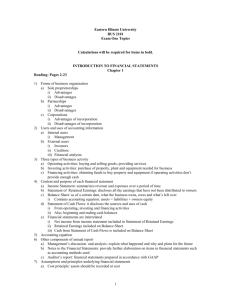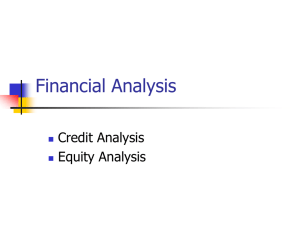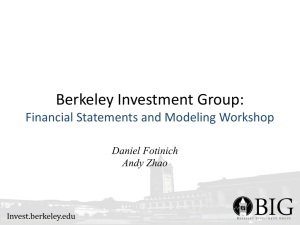balance sheet performance ratios
advertisement
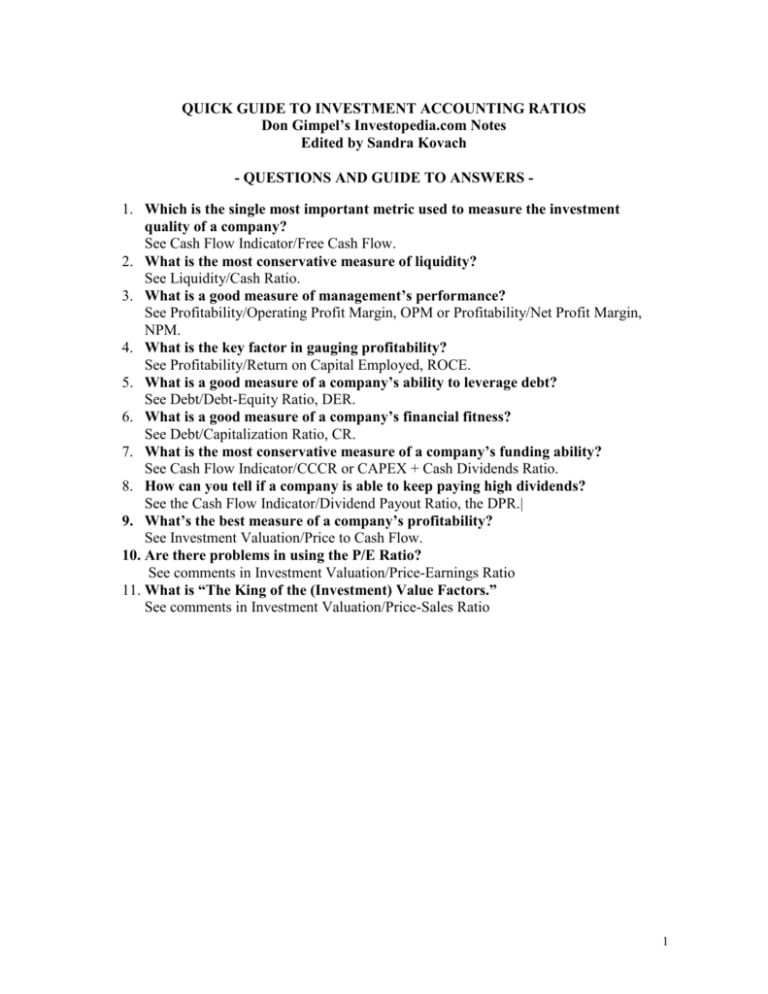
QUICK GUIDE TO INVESTMENT ACCOUNTING RATIOS Don Gimpel’s Investopedia.com Notes Edited by Sandra Kovach - QUESTIONS AND GUIDE TO ANSWERS 1. Which is the single most important metric used to measure the investment quality of a company? See Cash Flow Indicator/Free Cash Flow. 2. What is the most conservative measure of liquidity? See Liquidity/Cash Ratio. 3. What is a good measure of management’s performance? See Profitability/Operating Profit Margin, OPM or Profitability/Net Profit Margin, NPM. 4. What is the key factor in gauging profitability? See Profitability/Return on Capital Employed, ROCE. 5. What is a good measure of a company’s ability to leverage debt? See Debt/Debt-Equity Ratio, DER. 6. What is a good measure of a company’s financial fitness? See Debt/Capitalization Ratio, CR. 7. What is the most conservative measure of a company’s funding ability? See Cash Flow Indicator/CCCR or CAPEX + Cash Dividends Ratio. 8. How can you tell if a company is able to keep paying high dividends? See the Cash Flow Indicator/Dividend Payout Ratio, the DPR.| 9. What’s the best measure of a company’s profitability? See Investment Valuation/Price to Cash Flow. 10. Are there problems in using the P/E Ratio? See comments in Investment Valuation/Price-Earnings Ratio 11. What is “The King of the (Investment) Value Factors.” See comments in Investment Valuation/Price-Sales Ratio 1 QUICK GUIDE TO INVESTMENT ACCOUNTING RATIOS These notes are based in part upon material found in www.investopedia.com/university/ratios LIQUIDITY … A measure of a company’s ability to pay its short-term debts Type/Measurement Current Ratio, CR or Current to Working Cash Position What it means The proportion of current assets available to cover current liabilities. The higher the ratio, the better Quick Ratio, QR, or Quick Assets Ratio, QAR This is a measure of the amount of the most liquid assets to cover current liabilities. The higher the ratio the better. Cash Ratio, CashR A refinement of the current ratio to cover current liabilities. The higher the ratio the better. The ratio CR = N / D N = Cash or cash equivalents + marketable securities + receivables and inventory D = Notes payable + current ST debt payables + accrued expenses+ taxes (1+5+2+3)/(35+11+32+34) QR = N / D N = Cash & Equivalents + ST Inventory + Accounts Receivable D = Current Liabilities (1+3+2)/33 Comments This method is flawed because a company is a going concern and its ability to cover it’s current debts is not really significant CashR = N / D N = Cash & Cash Equivalents + Invested Funds D = Current Liabilities 1/33 The most conservative liquidity measure. It is not realistic to have a CR>1 because it might be considered poor asset utilization. The most liquid assets available to cover current liabilities. A more conservative valuation than the Current Ratio. The “quickness” of the ratio depends upon the time required to collect receivables. # Days a company’s cash is tied up in production and sales. The shorter the better. Note: The numbers in column 3 refer to Balance Sheet or P&L line items. Cash Conversion Cycle, CCC 2 PROFITABILITY … A measure of a company’s valuation Type/Measurement Profit Margin, GPM Operating Profit M., OPM Pretax Profit Margin, PPM Net Profit Margin, NPM What it means These four ratios measure a company’s ability to make money. The higher the ratio the better. Effective Tax Rate, ETR Provides a good understanding of a company’s tax rate. Return on Assets, ROA This shows how profitable a company is compared to total assets. The higher the better. This compliments the ROE by adding debt liabilities. Return on Capital Employed,. ROCE The ratio GPM = Gross Profit / Net Sales = ( 1 – Cost of Goods Sold / Net Sales) 16-COGS/16 OP = Gross Profit – Operating Expenses (16-COGS)-36 OPM = OP / Net Sales = (Gross Profit–Selling Exp.-GA ) / Net sales ((16-COGS)-37-38)/16 PPM = Pretax Profit / Net Sales 17/16 NPM = Net Income / Net Sales 18/16 GA = General & Administrative Expenses ETR = Income Tax Expenses / Pre Tax Income 20/17 ROA = Net Income / Average Total Assets 18/19 AVG ROCE = Net Income + Capital Employed 18+(11+12AVG)+8AVG Capital Employed = Avg. Debt + Average Shareholders Equity Comments GPM measures how efficiently a company uses its raw materials, labor and mfg.-related assets. Management has real control of OPM so this is a good measure of performance. PPM is similar to OPM. NPM is the bottom line and a good performance measure.. Some analysts prefer to use the pretax profit instead of the net profit number for the profitability. This is best used for historical purposes because businesses vary widely in their Fixed Asset requirements. Factoring debt liability into the total capital provides a more comprehensive measure of how well management is using debt. Focus on ROCE as the key factor to gauge profitability. ROCE should be >= a company’s borrowing rate. 3 DEBT … A measure of how well a company is using outside assets in its operations. Type/Measurement Overview of Debt Debt Ratio, DR Debt-Equity Ratio, DER Capitalization Ratio, CapR Interest Coverage Ratio, ICR Cash Flow to Debt Ratio, CFDR, or Free Cash Flow to Debt Ratio, FCFDR What it means The ratio Comments This measures the total debt to total assets, a measure of a company’s debt leverage. The lower the better. This is another leverage ratio. This measures how much suppliers, lenders, creditors and obligors have committed versus shareholders. The lower the ratio. This ratio provides a key insight into a company’s use of leverage. This is an excellent measure of investment quality. The lower the ratio the better. This determines how easily a company can pay interest on its debts. The higher the ratio the better. This ratio provides an indication of a company’s ability to cover its total debt with its yearly cash flow. The higher the ratio, the better. DR = Total Liabilities / Total Assets 7/6 The Debt Ratio provides a quick take on a company’s financial leverage. DER = Total Liabilities / Shareholders Equity 7/8 An easy-to-calculate ratio provides a general indication of a company’s equity-liability relationship. DER provides a more dramatic perspective on a company’s leverage than DR. CapR = LT Debt/(LT Debt + Shareholders Equity) 12((12+8) This measures financial fitness. One of the more meaningful debt ratios. EBIT – Earnings before Interest and Taxes 9 ICR = EBIT / Interest Expense 9/10 Total Debt = ST + LT debt 11+12 CFDR = Operating Cash Flow / Total Debt Other = Redeemable Preferred Stock + 2/3 of principal of non-cancellable operating leases. 13/(11+12) FCFDR = Operating Cash Flow/(Total Debt + Other) 13/(11+12) When ICR < 1.5, the company’s ability to meet its interest expenses is questionable. A high double-digit ratio is a sign of financial strength. A low ratio indicates too much debt or weak cash flow generation. 4 OPERATING PERFORMANCE … A broad measures of a company’s operating health Type/Measurement What it means The ratio Fixed-Asset This is a rough estimate of the FAT = Revenue / (Property + Plant + Equipment) Turnover, FAT productivity of a company’s 14/15 fixed asset utilization. The higher the ratio, the better. Sales Revenue per Employee, SRE This a measure of personal productivity as Net Sales per Employee SRE = Revenue / # Employees = Net Sales / # Employees 14/#Employees 16/#Employees Operating Cycle, OC A measurement of management performance similar to the CCC. The fewer the # days, the better. OC = DIO + DSO – DPO DIO = # Days Inventory outstanding = Average Inventory divided by Cost of Sales/day Average Inventory = (Io + Ie) / 2 Cost of Sales per day = Annual Cost of Sales/365 THINK OF THIS AS CASH SENT OUT AND THE CASH COLLECTED. MORE IMPORTANT WITH THE RETAIL SECTOR. LOOK FOR THIS INFORMATION IN THE NOTES Comments This measures a company’s efficiency in managing fixed assets. Best used with historical ratios to establish trends. This ratio is highly dependent on the company’s kind of business Like others in this class, this measure is highly dependent upon the nature of the business. It is best used to determine trends among competitors. The more efficient the collection operations, the better. The slower the payables are paid, the better. The lower the inventory to sales ratio, the better. When using the OC, look for historical consistency. DSO = # Days Receivable’s Outstanding = Average Accounts Receivable/Net Sales per day Avg. Acct. Rec = (Initial + Final)Acct. Rec. / 2 Net Sales / Day = Annual Net Sales / 365 DPO = # Days Payables Outstanding = Avg. Accts. Payable / Cost of Sales per day Avg. Acct. Payable = (Init. + Final ) Payables/2 Cost of Sales/Day = Annual Cost of Sales / 365 5 CASH FLOW INDICATOR … A measure of how efficiently a company uses its cash assets Type/Measurement Operating Cash Flow to Sales Ratio, OCF/S Free Cash Flow to Operating Cash Flow, FCF/OCF Cash Flow Coverage Ratio, CCCR Dividend Payout Ratio, DPR What it means The Operating Cash Flow to Sales Ratio measures how the cash generated from operations varies over time. Generally, the greater the ratio, the better. This is the fraction of cash flow available for expansion, acquisitions and/or financial stability to enable a company to weather difficult conditions. The higher the ratio, the better. These are measures of the ability of a company’s OCF to meet its obligations. The higher the ratio the better. Measures the fraction of earnings allocated for cash dividends. This is a measure of how well earnings support the dividend payment. The smaller the ratio the better. The ratio OCF/S = Operating Cash Flow / Sales OCF is taken from the Cash Flow Statement. Net Sales is taken from the Income Statement 13/16 FCF/OCF=(1–Capital Exp./Operating Cash Flow) 1-(17/13) STDC = OCF / ST Debt 13/11 CEC = OCF / Cap. Exp. 13/17 DC = OCF / Cash Dividends 13/21 CAPEX + Cash Dividends Ratio = OCF / (Cash Expenditures + Cash Dividends ) 13/17+21 DPR = Dividends per Common Share Earnings per Share (21/24)/(18/24) Comments There are three sources of cash flow: (1) from operations, (2) from Investing and (3) from Financing. Use only the part derived from operations, which is usually the foremost source of cash. Many investment institutions value Free Cash Flow ahead of earnings as the single most important financial metric used to measure the investment quality of a company. These ratios determine the company’s funding ability. The last ratio is a really stringent measure that puts cash to the ultimate test. It is “free cash flow on steroids” and indicates high investment quality This ratio is only used for dividend paying companies. Look for consistent or steadily increasing ratios. Be skeptical of excessively high dividends because the company might not be able to keep it up triggering a sharp stock price decline. 6 INVESTMENT VALUATION … A measure of how an investment is valued Type/Measurement Per Share Data Price to Book Value Ratio, PB What it means The ratio Comments This ratio is how many times a company’s stock value is trading per share compared to a company’s book value per share PB = Stock Price / Shareholder’s Equity per share 23/(8/24) Price to Cash Flow Ratio, PCF This ratio is used to evaluate an investment’s attractiveness. The lower the ratio the better. PCF = Stock price / Operating Cash Flow per share 23/(13/24) Price to Earnings Ratio, PE This is the best known investment valuation indicator. PE = Stock Price / Earnings per share 23/(18/24) Substitutions for the denominator include: TTM = Trailing Twelve-month Earnings/Share Obtain from 25 Price/Sales Ratio FEPS = Estimate future 12-month Earnings/Share Obtain from 22 Earnings per Share Growth – Growth is an estimate When a company’s stock price is less than it’s book value then (1) the stock is undervalued and represents a buying value or (2) if that evaluation is correct, the investment will be perceived as a losing proposition or at best a stagnant investment This ratio is similar to PB but many analysts consider it more reliable for evaluating acceptability of current pricing because it is not as easily manipulated. This ratio is often optimistic during bull markets and pessimistic during bear markets. It should be looked at skeptically particularly if forward earnings estimates are used. High P/Es imply a growth company where potential investors are willing to pay extra for potential growth. This ratio is highly sensitive to changes in accounting practices. Price to Earnings to Growth Ratio, PEG The PEG Ratio is a refinement of the PE Ratio made by including the growth factor in the denominator into the current valuation. It measures the degree to which high PE’s and growth are correlated. PEG = PE / G (23/(18/24))/22 Here, G is the E/S Growth. This is a variation of Graham-Dodds valuation equation P = aE*(1 + bG) rewritten to the form + (P/E) / (a*(1 + bG )) Graham and Dodd found that the constants a and b depend upon the company’s specific industrial classification. If the PEG = 1. the market is currently valuing a stock in accordance with the stock’s current estimated earning per share growth. If the value is <L1, the stock is undervalued and if >1, overvalued. The PEG Ratio determines the degree of reliability of the assumption that high prices and growth are related. It is common to encounter estimates of a company’s future growth that are incorrect. See Value Line’s reports that are available free at most public libraries. 7 Price to Sales Ratio, P/S Dividend Yield, DY Enterprise Value Multiple, EVM, in years A stock valuation indicator similar to the P/E Ratio except it measures valuation against Annual Sales. The lower the ratio, the better. A measure of valuation as the annual dividend per share divided by the stock price per share P/S = Stock price per share / Net Sales per share 23/(16/24) This is the ratio of the “enterprise value” by EBITDA. It measures how long it would take for an acquisition to pay off its costs. EVM = EV / EBITDA EV = Market Capitalization + Debt + Minority Interest + Preferred Stock – Cash – Cash Equivalents. EBITDA = Earnings before Interest, Taxes, Depreciation and Amortization DY = Ann. Dividend/Share / Stock Price per Share (21/24)/23 According to James O’Shaughghnessy author of “What Works on Wall Street,” this ratio is “The King of Value Factors.” It beats all others and does so consistently. This measure depends on the nature of the company’s business, whether it’s “value” or “growth” oriented, earnings, cash-flow and dividend policies. The value of this indicator depends on whether the investor favors value or growth. The EVM is influenced by investor sentiment and market conditions. It measures the value of a company as a going concern. (23*24)/21+(11+12)+26-27 8 QUICK GUIDE TO INVESTMENT ACCOUNTING RATIOS - ABBREVIATIONS CAPEX Capital Expenditure Coverage CapR Capitalization Ratio CashR Cash Ratio CCC Cash Conversion Cycle CFDR Cash Flow to Debt Ratio CR Current Ratio DC Dividend Coverage DER Debt-Equity Ratio DIO # Days Inventory Outstanding DPO # Days Payables Outstanding DPR Dividend Payout Ratio DR Debt Ratio DSO # Days Receivables Outstanding DY Dividend Yield EBIT Earnings Before Interest and Taxes EBITDA Earnings before Interest, Taxes, Depreciation and Amortization EPS Earnings (ex post) earnings per share ETR Effective Tax Rate EV Enterprise Value EVM Enterprise Value Multiple FAT Fixed-Asset Turnover FCF Free Cash Flow FCF/OCF Free Cash Flow to OCF Ratio FCFDR FEPS G GPM ICR NPM OC OCF OCF/S OPM PB PCF PE PEG PPM QAR QR ROA ROCE S SRE STDC TTM Free Cash Flow to Debt Ratio Forward (ex ante) Earnings per share Earnings per share growth Gross Profit Margin Interest Coverage Ratio Net Profit Margin Operating Cycle, Days Operating Cash Flow Operating Cash Flow to Sales Operating Profit Margin Price to Book Ratio Price to Cash Flow Ratio Price to Earnings Ratio Price to Earnings Growth Ratio Pretax Profit Margin Quick Assets Ratio Quick Ratio Return on Assets Return on Capital Employed Sales, Net Net Sales per Employee Short-term Debt Coverage Trailing 12-Month (Earnings per share) 9 QUICK GUIDE TO INVESTING ACCOUNTING RATIOS - LOCATION OF BALANCE SHEET AND PROFIT/LOSS STATEMENT ITEMS ITEM Accounts Receivable Assets, Total Book Value Capital Employed Capital Expenditures Cash Cash, Dividends Cash, Equivalents Cash, Flow Cash, Free Cash Cash Flow, Operating Cost of Goods Sold Debt, Average Debt, Current Short-Term Debt, Long-Term Dividend Payout Ratio Dividend Yield Earnings Earnings per Share Growth Employees, number Enterprise Value Enterprise Value Multiple Expense, Accrued Expense, General & Administrative (GA) Expense, Income Tax Expense, Interest Expense, Operating Expense, Selling Income, Net Income, Pre-Tax Inventory Invested Funds Liabilities, Current Liabilities, Total Minority Interest Notes payable Preferred Stock, redeemable Price to Sales Ratio Property, Plant & Equipment Profit, Gross Profit, Pretax Receivables Sales, Net Securities, Marketable Shareholders Equity, Average Taxes Payable LOCATION Balance Sheet/Assets/Current Assets Balance Sheet/Assets/Total Assets Balance Sheet/Equity Balance Sheet/Equity Balance Sheet/Fixed Assets/Property Balance Sheet/Current Assets/Cash Income Statement/Footnotes/Dividends per share Balance Sheet/Assets/Current Assets/Cash & Cash Equivalents Cash Flow Statement Cash Flow Statement Cash Flow Statement Income Statement/Expenses/Total Balance sheet/Liabilities and Equity/Long-Term Liabilities./LT Balance sheet/Liabilities/Current portion of bank loans Balance Sheet/Liabilities & Equity/LT/Bank Loans Income Statement/ Footnotes Income Statement/Footnotes Income Statement/Net Earnings Income Statement/Footnotes Personnel Records Income Statement/Total Expenses Income Statement/Expenses/G&A Income Statement/Scheduled Expenses Income Statement/Scheduled Expenses Income Statement/Variable Expenses Income Statement/Variable Expenses Income Statement/Net Earnings Income Statement/Net Earnings Balance Sheet/Assets/Current Assets/Inventory Income Statement/Operating Income/Interest Income Balance Sheet/Liabilities & Equity/Current Liabilities/Total Balance Sheet/Liabilities & Equity/Total Liabilities Balance Sheet/Liabilities & Equity/Current Liabilities/Current Portion of Bank Loans Balance Sheet/Equity Income Statement/Footnote Balance Sheet/Assets/Fixed Assets/Property, Plant and Equipment Income Statement/Gross Profits Income Statement/Profit Balance Sheet/Assets & Equity/Current Assets/Acct. Receivable Income Statement/Revenues/Sales Net Balance Sheet/Assets/Current Assets/Cash & Cash Equivalents Balance Sheet/Equity/Per share capital Balance Sheet/Liabilities and Equity/Current and Long Term Liabilities/Taxes Payable 10 INCOME (PROFIT & LOSS) AND QUICK CASH FLOW STATEMENTS REVENUES Net Operating Sales Other Income 14 TOTAL REVENUE QUICK GUIDE REFERENCE Net sales Interest Income Total revenue 9 EXPENSES 36 Operating Total 37 Selling 38 G&A TOTAL EXPENSES Expenses, operating Selling expense General & Administrative Expense Total expenses 16 EBITDA Earnings before Interest, Taxes, Depreciation & Amortization SCHEDULED EXPENSES Interest Depreciation and Amortization 17 Pre-tax Profit 20 Taxes TOTAL SCHEDULED EXPENSES 10 18 21 24 23 22 25 Pre-tax Profit NET EARNINGS Net Earnings NOTES Cash dividends Average # shares outstanding in period Stock price at close of period Earnings per share growth Price/Sales Ratio CASH FLOW CASH FLOW + Net Earnings + Depreciation and Amortization - Change in working capital - Funds Invested in Period 13 QUICK CASH FLOW Quick Cash Flow 11 BALANCE SHEET AND SHAREHOLDERS EQUITY ASSETS 1 2 3 4 5 6 CURRENT ASSETS Cash & Cash equivalents Accounts Receivable Inventory Prepaid expenses Securities, marketable Other current assets 15 FIXED ASSETS Property, Plant and Equipment QUICK GUIDE REFERENCE 27 Cash & Cash Equivalents Accounts Receivable, Receivables Securities, marketable 17 Capital expenditures (fixed asset purchases) 19 Total Assets 34 35 Taxes payable Notes payable 11 Current short-term debt, Liabilities-current 12 Debt, long-term 24 Shareholders equity per share 15 Preferred stock redeemable Goodwill Other intangible fixed assets 6 TOTAL ASSETS LIABILITIES AND SHAREHOLDERS EQUITY 8 9 10 30 32 33 CURRENT LIABILITIES Accounts Payable Current Income Taxes Current portion of bank loans Short-term provisions Other Total Short-term Liabilities LONG TERM LIABILITIES Bank loans Issued debt securities Deferred tax liability 26 Provisions – minority interest 7 Total Long-term Liabilities TOTAL LIABILITIES EQUITY Per Share capital Capital reserves Revaluation reserves Retained profits Preferred stock redeemable NOTES Book value Book value 12
